The U.S. government has imposed stringent licensing restrictions, affecting the export of certain NVIDIA graphics processors and accelerators to China.
NVIDIA, a leading name in the graphics processing unit (GPU) market, is grappling with the implications of these new regulations. The company had been proactive in tailoring its products, especially those based on the Ampere and Hopper architectures, to align with previous U.S. export rules. However, the recent changes have introduced a new set of criteria that could potentially disrupt the shipment of these specialized products.
Earlier restrictions were primarily centered around on-device connection speeds. The updated licensing rules, however, are pegged to a performance threshold. This shift has brought NVIDIA’s custom A800 and H800 chips, designed specifically for the Chinese market, under the regulatory scanner. Adding to the complexity, the RTX 4090 gaming GPU, a consumer favorite, also falls within the ambit of these rules, as NVIDIA disclosed in a recent SEC filing.
On delving deeper into the regulatory changes, it’s evident that the U.S. aims to curb access to high-performance computing chips. The primary objective behind this move is to stymie China’s technological advancements, especially in areas with potential military applications. The revised regulations also plug certain gaps that previously allowed companies outside the U.S. to procure these chips and subsequently export them to certain restricted areas in China.
For NVIDIA, the challenges are manifold. The RTX 4090 series, a consumer-grade product, is particularly at risk. Several Chinese firms play a pivotal role in the final packaging of these GPUs, and a significant number of board partners operate exclusively in China.
Stay updated with the latest news in gaming and esports by signing up for early access to TalkEsport’s Mobile App. Follow us on Twitter and Google News to ensure you never miss the exciting updates.


Deixar um comentário